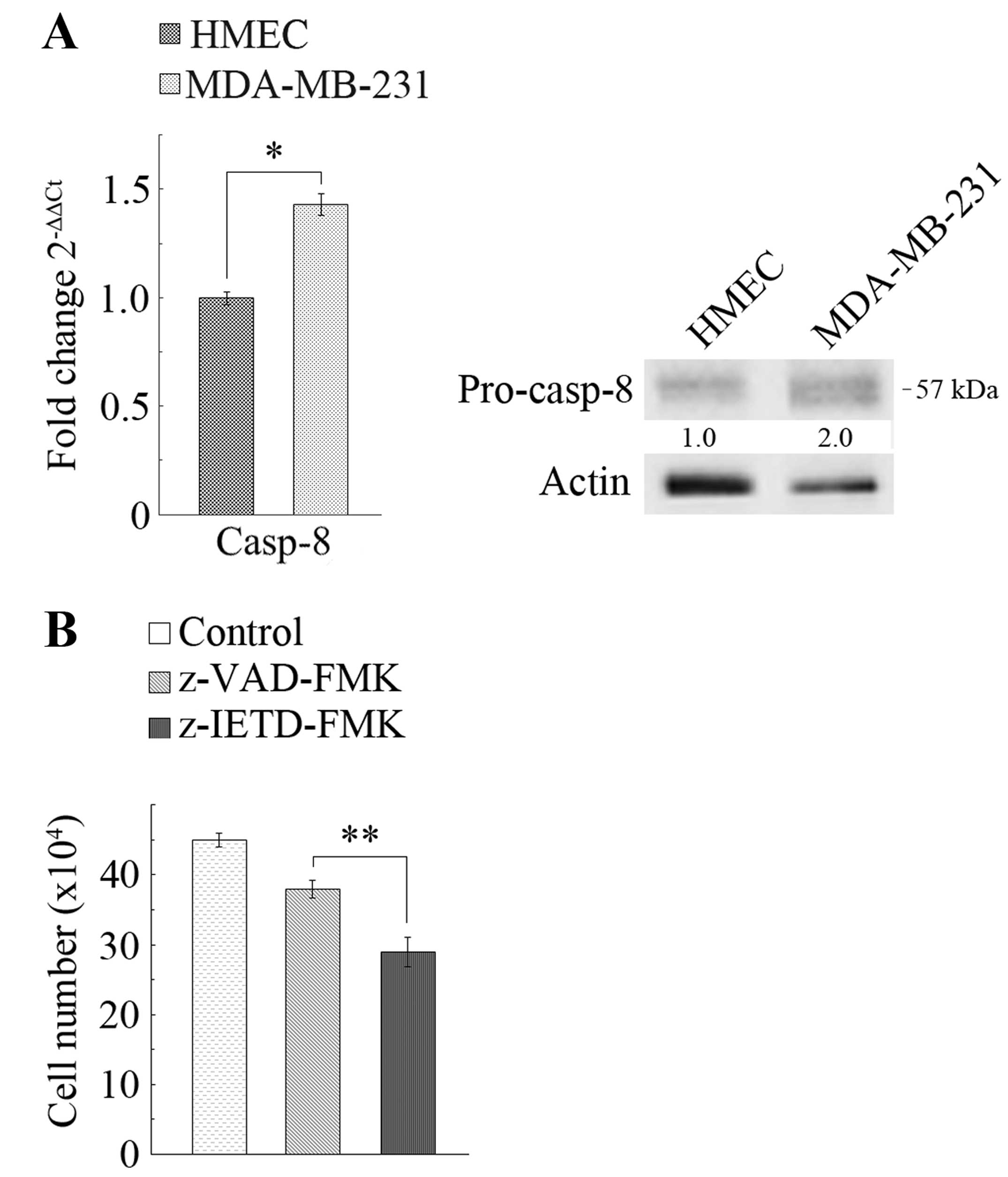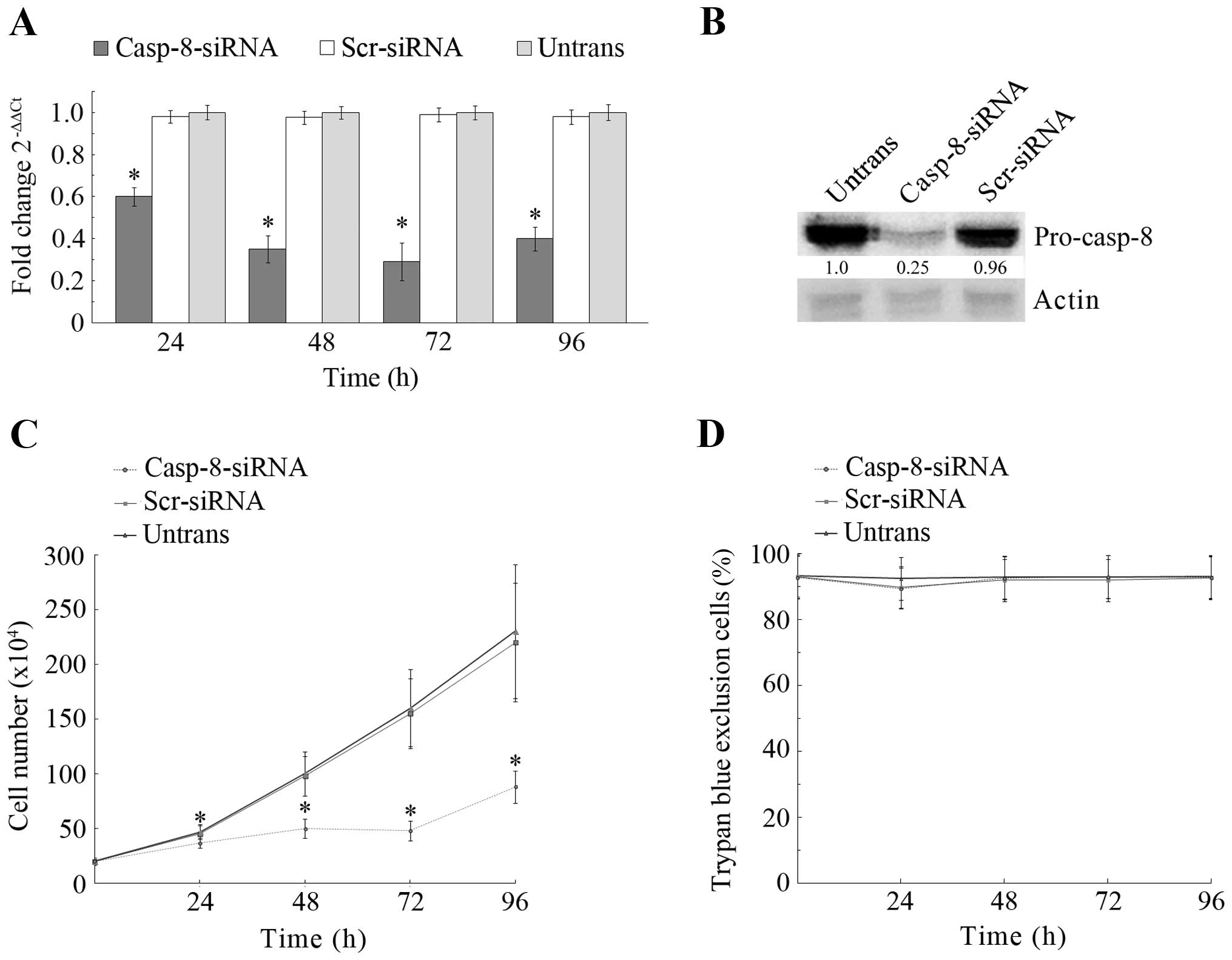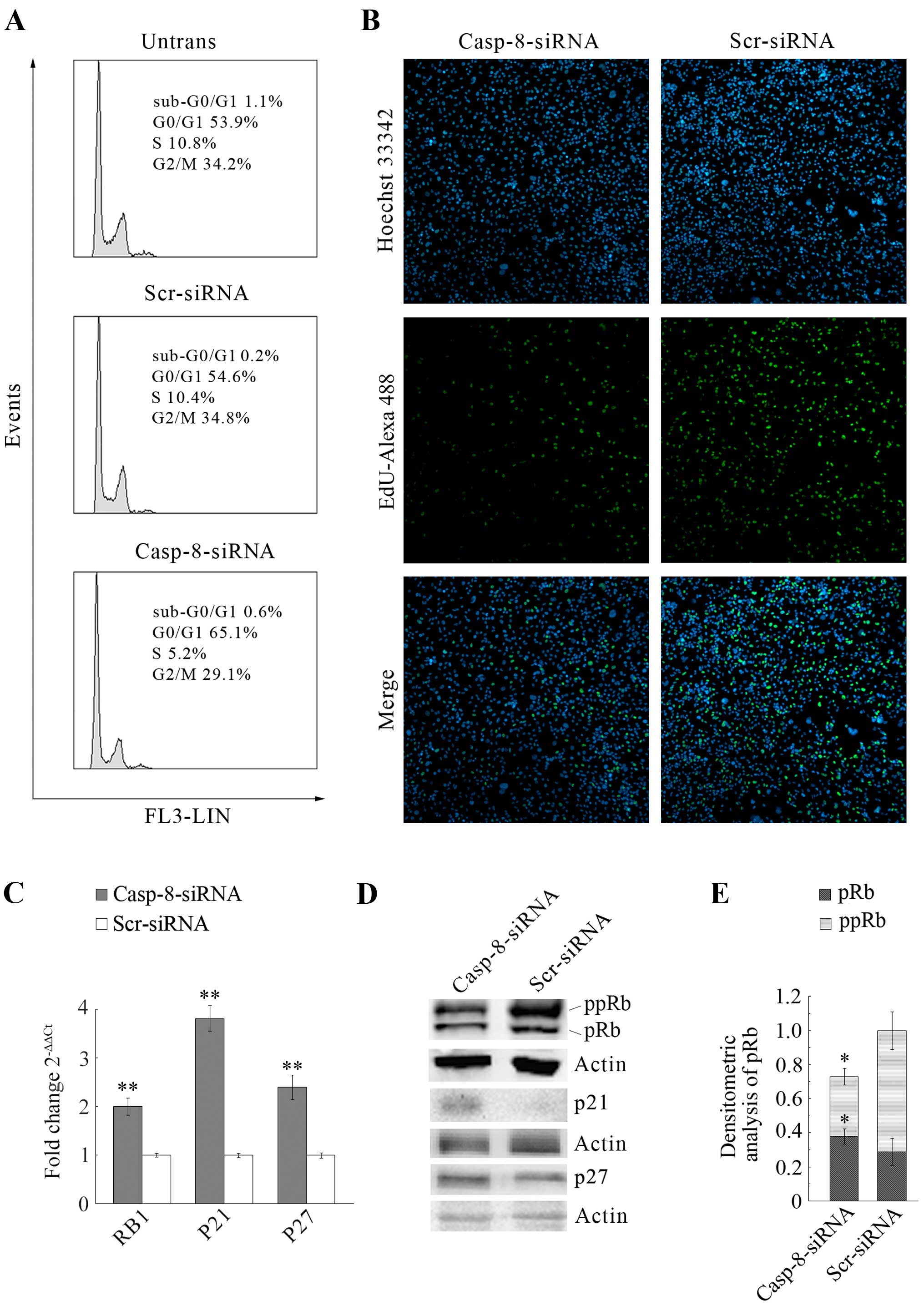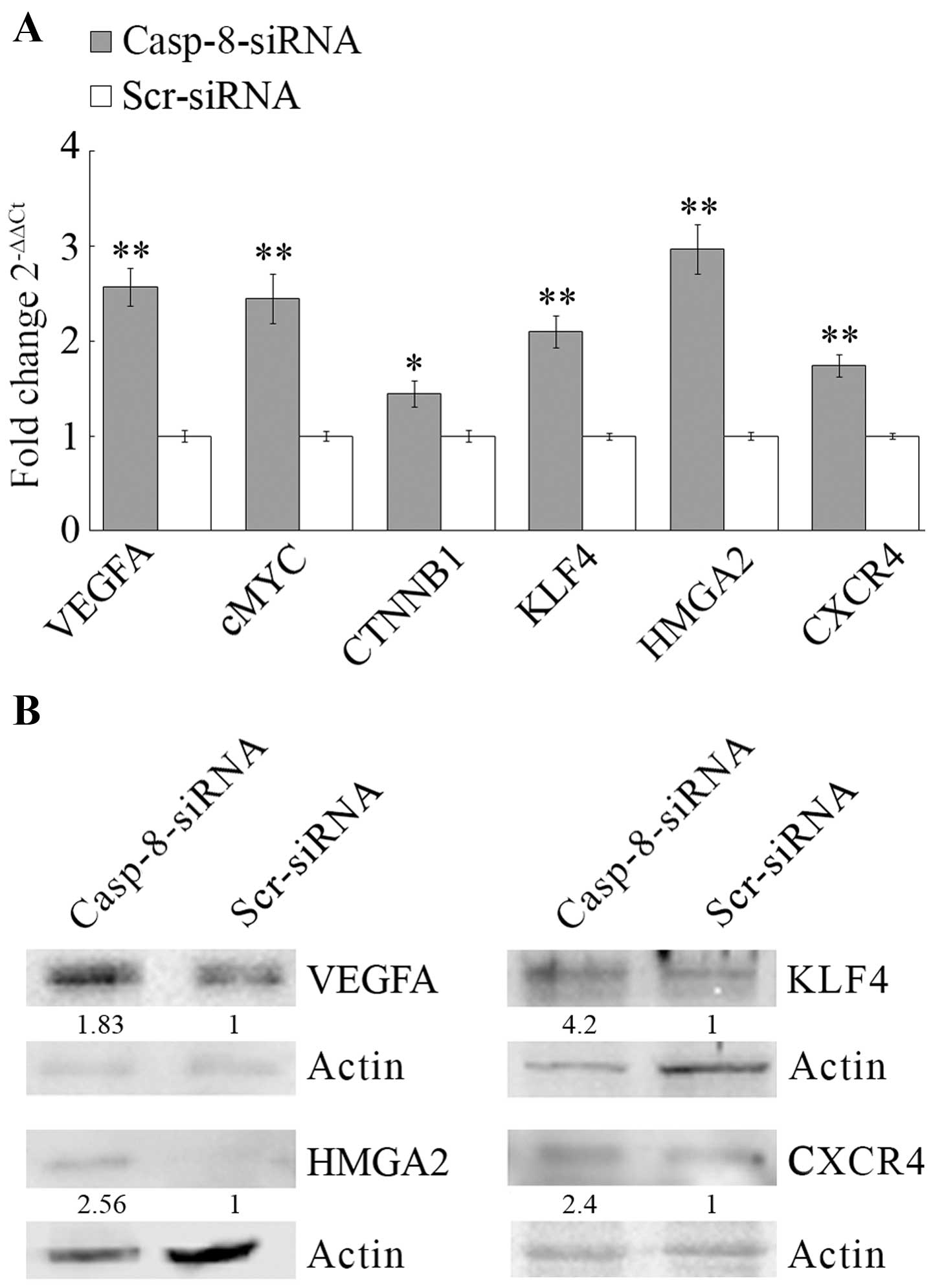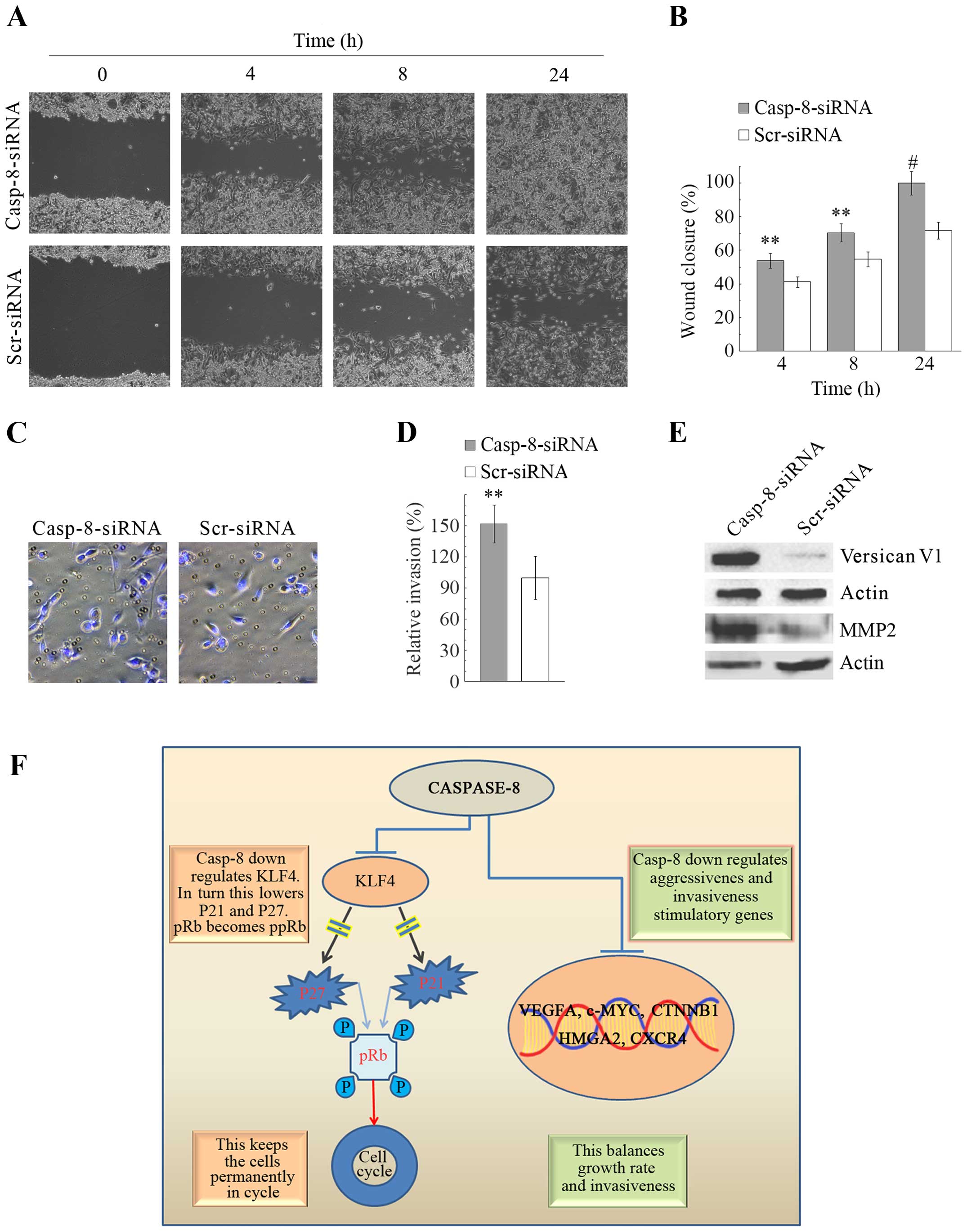|
1
|
Kim HS, Lee JW, Soung YH, Park WS, Kim SY,
Lee JH, Park JY, Cho YG, Kim CJ, Jeong SW, et al: Inactivating
mutations of caspase-8 gene in colorectal carcinomas.
Gastroenterology. 125:708–715. 2003. View Article : Google Scholar : PubMed/NCBI
|
|
2
|
Torres VA, Mielgo A, Barbero S, Hsiao R,
Wilkins JA and Stupack DG: Rab5 mediates caspase-8-promoted cell
motility and metastasis. Mol Biol Cell. 21:369–376. 2010.
View Article : Google Scholar :
|
|
3
|
Stupack DG, Teitz T, Potter MD, Mikolon D,
Houghton PJ, Kidd VJ, Lahti JM and Cheresh DA: Potentiation of
neuroblastoma metastasis by loss of caspase-8. Nature. 439:95–99.
2006. View Article : Google Scholar : PubMed/NCBI
|
|
4
|
Teitz T, Wei T, Valentine MB, Vanin EF,
Grenet J, Valentine VA, Behm FG, Look AT, Lahti JM and Kidd VJ:
Caspase 8 is deleted or silenced preferentially in childhood
neuroblastomas with amplification of MYCN. Nat Med. 6:529–535.
2000. View Article : Google Scholar : PubMed/NCBI
|
|
5
|
Pingoud-Meier C, Lang D, Janss AJ, Rorke
LB, Phillips PC, Shalaby T and Grotzer MA: Loss of caspase-8
protein expression correlates with unfavorable survival outcome in
childhood medulloblastoma. Clin Cancer Res. 9:6401–6409.
2003.PubMed/NCBI
|
|
6
|
Skiriute D, Vaitkiene P, Saferis V,
Asmoniene V, Skauminas K, Deltuva VP and Tamasauskas A: MGMT,
GATA6, CD81, DR4, and CASP8 gene promoter methylation in
glioblastoma. BMC Cancer. 12:2182012. View Article : Google Scholar : PubMed/NCBI
|
|
7
|
Hopkins-Donaldson S, Ziegler A, Kurtz S,
Bigosch C, Kandioler D, Ludwig C, Zangemeister-Wittke U and Stahel
R: Silencing of death receptor and caspase-8 expression in small
cell lung carcinoma cell lines and tumors by DNA methylation. Cell
Death Differ. 10:356–364. 2003. View Article : Google Scholar : PubMed/NCBI
|
|
8
|
Soung YH, Lee JW, Kim SY, Sung YJ, Park
WS, Nam SW, Kim SH, Lee JY, Yoo NJ and Lee SH: Caspase-8 gene is
frequently inactivated by the frameshift somatic mutation
1225_1226delTG in hepatocellular carcinomas. Oncogene. 24:141–147.
2005. View Article : Google Scholar
|
|
9
|
Soung YH, Lee JW, Kim SY, Jang J, Park YG,
Park WS, Nam SW, Lee JY, Yoo NJ and Lee SH: Caspase-8 gene is
inactivated by somatic mutations in gastric carcinomas. Cancer Res.
65:815–821. 2005.PubMed/NCBI
|
|
10
|
American Cancer Society. Surveillance and
Heath Services Research. 2015, http://www.cancer.org/research/cancerfactsstatistics/cancerfactsfigures2015/.
|
|
11
|
Zhang J, Wang Y, Yin Q, Zhang W, Zhang T
and Niu Y: An associated classification of triple negative breast
cancer: The risk of relapse and the response to chemotherapy. Int J
Clin Exp Pathol. 6:1380–1391. 2013.PubMed/NCBI
|
|
12
|
Bauer KR, Brown M, Cress RD, Parise CA and
Caggiano V: Descriptive analysis of estrogen receptor
(ER)-negative, progesterone receptor (PR)-negative, and
HER2-negative invasive breast cancer, the so-called triple-negative
phenotype: a population-based study from the California cancer
Registry. Cancer. 109:1721–1728. 2007. View Article : Google Scholar : PubMed/NCBI
|
|
13
|
Bayraktar S and Glück S: Molecularly
targeted therapies for metastatic triple-negative breast cancer.
Breast Cancer Res Treat. 138:21–35. 2013. View Article : Google Scholar : PubMed/NCBI
|
|
14
|
Yagata H, Kajiura Y and Yamauchi H:
Current strategy for triple-negative breast cancer: Appropriate
combination of surgery, radiation, and chemotherapy. Breast Cancer.
18:165–173. 2011. View Article : Google Scholar : PubMed/NCBI
|
|
15
|
Pogoda K, Niwińska A, Murawska M and
Pieńkowski T: Analysis of pattern, time and risk factors
influencing recurrence in triple-negative breast cancer patients.
Med Oncol. 30:3882013. View Article : Google Scholar : PubMed/NCBI
|
|
16
|
D'Anneo A, Carlisi D, Lauricella M, Puleio
R, Martinez R, Di Bella S, Di Marco P, Emanuele S, Di Fiore R,
Guercio A, et al: Parthenolide generates reactive oxygen species
and autophagy in MDA-MB231 cells. A soluble parthenolide analogue
inhibits tumour growth and metastasis in a xenograft model of
breast cancer. Cell Death Dis. 4:e8912013. View Article : Google Scholar : PubMed/NCBI
|
|
17
|
Carlisi D, Lauricella M, D'Anneo A,
Emanuele S, Angileri L, Di Fazio P, Santulli A, Vento R and
Tesoriere G: The histone deacetylase inhibitor suberoylanilide
hydroxamic acid sensitises human hepatocellular carcinoma cells to
TRAIL-induced apoptosis by TRAIL-DISC activation. Eur J Cancer.
45:2425–2438. 2009. View Article : Google Scholar : PubMed/NCBI
|
|
18
|
Lauricella M, Ciraolo A, Carlisi D, Vento
R and Tesoriere G: SAHA/TRAIL combination induces detachment and
anoikis of MDA-MB231 and MCF-7 breast cancer cells. Biochimie.
94:287–299. 2012. View Article : Google Scholar
|
|
19
|
Carlisi D, Lauricella M, D'Anneo A,
Buttitta G, Emanuele S, di Fiore R, Martinez R, Rolfo C, Vento R
and Tesoriere G: The synergistic effect of SAHA and parthenolide in
MDA-MB231 breast cancer cells. J Cell Physiol. 230:1276–1289. 2015.
View Article : Google Scholar
|
|
20
|
Di Fiore R, Marcatti M, Drago-Ferrante R,
D'Anneo A, Giuliano M, Carlisi D, De Blasio A, Querques F, Pastore
L, Tesoriere G, et al: Mutant p53 gain of function can be at the
root of dedifferentiation of human osteosarcoma MG63 cells into
3AB-OS cancer stem cells. Bone. 60:198–212. 2014. View Article : Google Scholar : PubMed/NCBI
|
|
21
|
Di Fiore R, Drago-Ferrante R, Pentimalli
F, Di Marzo D, Forte IM, D'Anneo A, Carlisi D, De Blasio A,
Giuliano M, Tesoriere G, et al: MicroRNA-29b-1 impairs in vitro
cell proliferation, self-renewal and chemoresistance of human
osteosarcoma 3AB-OS cancer stem cells. Int J Oncol. 45:2013–2023.
2014.PubMed/NCBI
|
|
22
|
Gorter A, Zijlmans HJ, van Gent H, Trimbos
JB, Fleuren GJ and Jordanova ES: Versican expression is associated
with tumor-infiltrating CD8-positive T cells and infiltration depth
in cervical cancer. Mod Pathol. 23:1605–1615. 2010. View Article : Google Scholar : PubMed/NCBI
|
|
23
|
Ricciardelli C, Sakko AJ, Ween MP, Russell
DL and Horsfall DJ: The biological role and regulation of versican
levels in cancer. Cancer Metastasis Rev. 28:233–245. 2009.
View Article : Google Scholar : PubMed/NCBI
|
|
24
|
Jäger R and Zwacka RM: The enigmatic roles
of caspases in tumor development. Cancers (Basel). 2:1952–1979.
2010. View Article : Google Scholar
|
|
25
|
Stupack DG: Caspase-8 as a therapeutic
target in cancer. Cancer Lett. 332:133–140. 2013. View Article : Google Scholar
|
|
26
|
Ell B and Kang Y: Transcriptional control
of cancer metastasis. Trends Cell Biol. 23:603–611. 2013.
View Article : Google Scholar : PubMed/NCBI
|
|
27
|
Weigelt B, Peterse JL and van ‘t Veer LJ:
Breast cancer metastasis: Markers and models. Nat Rev Cancer.
5:591–602. 2005. View
Article : Google Scholar : PubMed/NCBI
|
|
28
|
Nakopoulou L, Tsirmpa I, Alexandrou P,
Louvrou A, Ampela C, Markaki S and Davaris PS: MMP-2 protein in
invasive breast cancer and the impact of MMP-2/TIMP-2 phenotype on
overall survival. Breast Cancer Res Treat. 77:145–155. 2003.
View Article : Google Scholar : PubMed/NCBI
|
|
29
|
Tiwari N, Meyer-Schaller N, Arnold P,
Antoniadis H, Pachkov M, van Nimwegen E and Christofori G: Klf4 is
a transcriptional regulator of genes critical for EMT, including
Jnk1 (Mapk8). PLoS One. 8:e573292013. View Article : Google Scholar : PubMed/NCBI
|
|
30
|
Shi Y and Ai W: Function of KLF4 in stem
cell biology. Biochemistry, Genetics and Molecular Biology
‘Pluripotent Stem Cells’. Bhartiya D and Lenka N: InTech; 2013
|
|
31
|
Rowland BD, Bernards R and Peeper DS: The
KLF4 tumour suppressor is a transcriptional repressor of p53 that
acts as a context-dependent oncogene. Nat Cell Biol. 7:1074–1082.
2005. View
Article : Google Scholar : PubMed/NCBI
|
|
32
|
Wei D, Kanai M, Jia Z, Le X and Xie K:
Kruppel-like factor 4 induces p27Kip1 expression in and suppresses
the growth and metastasis of human pancreatic cancer cells. Cancer
Res. 68:4631–4639. 2008. View Article : Google Scholar : PubMed/NCBI
|
|
33
|
Nagata T, Shimada Y, Sekine S, Hori R,
Matsui K, Okumura T, Sawada S, Fukuoka J and Tsukada K: Prognostic
significance of NANOG and KLF4 for breast cancer. Breast Cancer.
21:96–101. 2014. View Article : Google Scholar
|



